Author: Irene Pramudito
02 November 2003
"Technical Diving". It's funny how such a simple phrase used to send shivers down my spine. It conjured up images of deep, dark caves, eerie wrecks, unimaginable depths. For the novice diver that I was, it was a scary world full of unpleasantness and seemingly unnecessary risks. I could not understand why people would want to venture into dark caves devoid of any aquatic life, penetrate wrecks full of hazardous wires and sharp edges, or go deep where the sun doesn't shine. Spending hours doing numerous decompression stops just didn't appeal to me. Can you imagine currents, cold water, and circling sharks when you're doing a 1-hour long decompression? Besides, how would a woman cope with carrying five or more tanks or a rebreather? The sheer weight would topple a lesser man, let alone a woman. See, my problem was that I had no idea what technical diving was. I couldn't see past that scary word "technical". After a little bit of research and a taste of enhanced air, I've realised that technical diving is not that scary after all. It just takes a little more effort, understanding, and time. (Plus a whole lot of money!) The rewards are great: you could explore extensive cave systems, dive deeper than a single-tank open circuit SCUBA systems allows, see weird deep-sea creatures, explore the inside of wrecks - the possibilities are endless. Now, let me take you on a journey to find out what tech diving is all about, so you can decide if a woman can do it.
What is technical diving? In layman terms, tech diving is any type of diving that goes beyond the depth limit of recreational and involves gas mixes other than air. So if you dive below 30 metres, you're doing a simple form of technical diving. If you're using a gas other than air (79% Nitrogen and 21% Oxygen), that's technical diving. But real tech diving starts when you actually plan a dive to a depth that requires decompression stops and different gas mixes. Note that when I say "decompression stops", I don't mean the obligatory 3 minutes at 5 metres. A decompression dive may have several stops along the way which are calculated in correlation to the planned depth. At each stop, a different gas mix is used. Also, tech diving could mean any dive in an overhead environment such as caves and the insides of wrecks. Another type of tech diving involves the use of semi-closed or closed circuit rebreather, a machine that "recycles" the CO2 we exhale into breathable air. The complexity of skills and "technical" knowledge needed to survive such dives coined the term "technical diving".
Is tech diving suitable for you? If you've heard the term "scuba diving is not for everyone", the same goes for tech diving. Some people are content to snorkel, some are happy to be an Open Water diver with a maximum depth of 18 metres, or an Advanced diver who can go 30 metres deep. But if you have the craving for deeper depths, cave or wreck explorations, and rebreather diving, then a foray into tech diving may just be what the doctor prescribes. Sure, it involves risks, more complex calculations, and specialised skills. But then to a snorkeler, so does scuba diving. Tech diving is just a matter of enhancing what you have learned in your initial Open Water/Advanced courses.
So, is it suitable for women? Don't be deterred by the predominantly male population in the tech diving community. Scuba diving used to be a male-dominated sport too, but now the number is almost equal. Very few woman divers have chosen the technical path, and even fewer have made it all the way to the instructor level. However, there is apparent evidence that women divers are starting to pick up tech diving. On a typical weekend at the Seven Skies wreck in the Anambas islands, for example, a smattering of women rigged up in twin tanks and deco bottles is a common sight. And before you ask, NO, they're not the butch, oversized type of ladies. In fact, most of them can be called "petite". The secret of their strength: the numerous tanks are only heavy when you're on land, in the water they become completely neutral. Besides, all divers with multiple tanks will be assisted when entering the water. No mere mortal can carry seven tanks and bounce around the dive deck unharmed.
It is also a known fact that more women are pursuing further education in tech diving. GUE (http://www.GUE.com), a US-based technical diving training agency, has noted a sharp increase in the number of female divers enrolling in their courses. IANTD (http://www.IANTD.com) is also churning out more and more female tech divers, gas blenders, and instructors. PADI (http://www.PADI.com) is another agency that offers tech diving courses.
Tech diving can be considered an option when you're planning to continue your diving education. Beyond the Advanced diver stage, there are two paths to choose from: one that leads to a dive professional (instructor/course director/commercial diver), and another that leads to a recreational tech diver. For those not cut out to be a teacher, a natural progression would be tech diving.
The first step into tech diving is to take the Enriched Air course which gives an introduction to the topic of diveable gases. Because tech diving involves the use of different gas mixes at different depths, it is essential that you know the benefits and effects of each gas. A certain percentage of Oxygen, for example, become toxic at a certain depth. This course, however, only concentrates on Oxygen-Nitrogen mix. If you want to learn more about other diving gases such as Heliox or Trimix, you will need to take a more advanced course such as GUE's Rec TriOx.
According to GUE, there are several types of tech diving, and each is a specialised type that needs separate training. However, there is also a pre-requisite to all of these tech courses: the DIR Fundamentals course. This course is the mother of all courses. It emphasises and aims to refine the basic necessities of diving skills such as buoyancy, buddy awareness, trim, streamlining, safety, and equipment configuration. In this course, you will be taught to ditch all your bad diving habits (kneeling on the sand instead of hovering, fear of mask clearing, slack buddy awareness, etc.). The equipment configuration part of the course will familiarise you with the Hogarthian configuration, which is the most common set-up for Tech Diving. You will learn how to use the long hoses, back plate and wing, stiff rubber fins, etc. This course act as an entry qualification gauge for further tech courses at GUE - if you fail, you will have to re-take the course before you can go to the next level. It is also so vigorous that you can actually notice the difference in your skills after just four dives - all recorded on video as required by the course syllabus. To see sample videos, check out www.fifthd.com. Even if you're not tech-inclined, you can take this course just to perfect your diving skills.
The next level is the specialisation courses: Tech, Cave, Wreck, or Rebreather, all of which has Level 1 and 2. You should select a course that matches your interest and long-term training plan. For example, if you're claustrophobic, forget about Cave or Wreck courses. On the other hand, if you are nervous about abyssal depths, stick to Cave and Wreck. All of these courses will prepare you for more advanced tech diving, if you are inclined to become a tech instructor or a commercial diver.
How does all that sound? Pretty damn exciting, if you ask me. It has all the ingredients of an "experience of a lifetime": challenge, novelty, opportunity to excel, a rewarding experience, and of course, the adrenaline rush! There's nothing like the feeling of triumph, when you realise you've beaten the odds and excel at something few women have ever had the chance to do. You've become a diver, so what's stopping you from becoming a better diver? I've taken my first step, and I dare you to take yours!

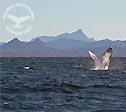

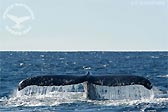



 On an earlier trip in February 2008, with the team from
On an earlier trip in February 2008, with the team from 

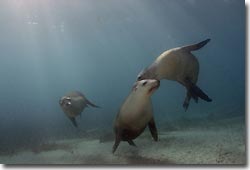 Wow ... they were everywhere - above, below and around us. 'Buzzing' me from top to bottom, I didn't know where to look next. These guys seemed to be just as excited to see us as we were to see them ... and in their state of excitement, they were looping, swimming in figure 8's and constantly on the move and I felt myself spinning around and around trying to catch a glimpse and lock focus on these beautiful animals.
Wow ... they were everywhere - above, below and around us. 'Buzzing' me from top to bottom, I didn't know where to look next. These guys seemed to be just as excited to see us as we were to see them ... and in their state of excitement, they were looping, swimming in figure 8's and constantly on the move and I felt myself spinning around and around trying to catch a glimpse and lock focus on these beautiful animals. Remembering Andrew's words during our brief, I held my ground ... but only to be left all alone - with no divers around me and certainly no sea lions. Where had they gone? Should I have followed them? But didn't Andrew say "Don't let them lead you away from the bay"?
Remembering Andrew's words during our brief, I held my ground ... but only to be left all alone - with no divers around me and certainly no sea lions. Where had they gone? Should I have followed them? But didn't Andrew say "Don't let them lead you away from the bay"? The Australian Sea Lion is a species of sea lion that breeds only on the south and west coasts of Australia. These animals are fascinating. Their inquisitive nature almost gives them a human like quality.
The Australian Sea Lion is a species of sea lion that breeds only on the south and west coasts of Australia. These animals are fascinating. Their inquisitive nature almost gives them a human like quality.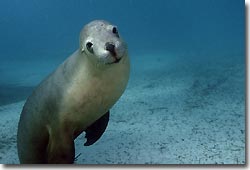



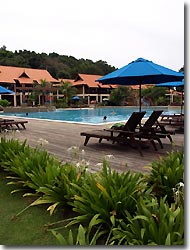 Our recent Malaysia itinerary included a 2-day 2-night stunt to Redang Island in the North East of peninsular Malaysia; escaping the Australian cold for a few days and getting some dives in.
Our recent Malaysia itinerary included a 2-day 2-night stunt to Redang Island in the North East of peninsular Malaysia; escaping the Australian cold for a few days and getting some dives in.
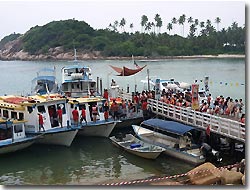
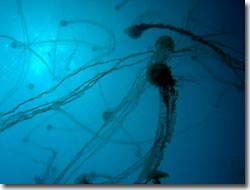 When the unavoidable finally happened I could not believe the pain ... one jelly had managed to hit my left leg and ankle (the booties I got were low-cut ankle free booties...).
When the unavoidable finally happened I could not believe the pain ... one jelly had managed to hit my left leg and ankle (the booties I got were low-cut ankle free booties...).  Then I heard Matt scream again ... he was hit again on his hand during the safety stop. We climbed onboard cursing and looking at our battle scars. We found the second group (which was a group of Open Water students) had their dive aborted by their instructor... which in hindsight seemed like the ONLY reasonable thing to do. After soaking my leg in a bottle of stinggoes (bless Australian technology ...) the pain temporarily subsided. Matt didn't stop cursing; his hand had swollen up more than my leg at that stage.
Then I heard Matt scream again ... he was hit again on his hand during the safety stop. We climbed onboard cursing and looking at our battle scars. We found the second group (which was a group of Open Water students) had their dive aborted by their instructor... which in hindsight seemed like the ONLY reasonable thing to do. After soaking my leg in a bottle of stinggoes (bless Australian technology ...) the pain temporarily subsided. Matt didn't stop cursing; his hand had swollen up more than my leg at that stage.  We should be able to trust the local knowledge of any dive centre to make decisions of where to go and who to take, but we can't. In this situation despite 20 years of diving experience, I trusted the dive centre staff to make the right decision on continuing the dive or aborting it. Seeing the sea of jellies I thought to myself if we continue through this, the stings can't be that bad and I followed ... I should have known better.
We should be able to trust the local knowledge of any dive centre to make decisions of where to go and who to take, but we can't. In this situation despite 20 years of diving experience, I trusted the dive centre staff to make the right decision on continuing the dive or aborting it. Seeing the sea of jellies I thought to myself if we continue through this, the stings can't be that bad and I followed ... I should have known better. 